LG C9 OLED (OLED55C9, OLED65C9, OLED77C9) review
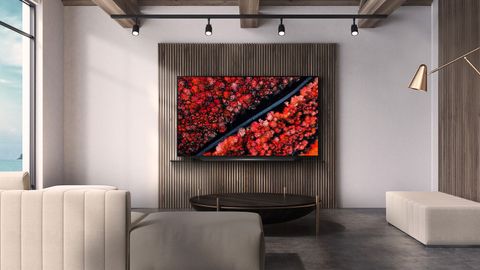
The success of OLED has created an interesting problem for LG - at this point, the company is basically competing against itself. That's because LG Display, the technology research arm of the company sells panels to every manufacturer except Samsung (no surprise there), leaving LG Electronics to face a crowded market place of its own design. So what can the Korean giant do?
Simple, it makes its OLED 4K TVs the most feature-packed that money can buy.
That said, the C9 represents the midrange for LG’s 2019 OLED TVs, adding the superior Alpha9 processor when compared to the cheaper B9, but avoiding the expensive cosmetic features found on models further up the range. As a result the pricing is as competitive as the specs are impressive.
Even better, just like the more expensive OLED TVs in the lineup, the C9 offers a 2nd generation Alpha9 processor with AI enhancements, improved sound with AI processing, and an upgraded smart platform with, you guessed it, added AI.
On top of everything else, there’s high dynamic range (HDR10, HLG, and Dolby Vision) and support for Dolby Atmos, plus HDMI 2.1. About the only feature not included is HDR10+, but otherwise these are very competitive OLEDs.
LG C9 OLED release date and price
No matter where you live in the world, the C9 comes in three screen sizes: a 55-inch , 65-inch (reviewed here) and a 77-inch model.
If you live in the UK, you'll be able to purchase the 55-inch OLED55C9PLA for £2,499, the 65-inch OLED65C9PLA for £3,299 and the 77-inch OLED77C9PLA for £7,499. In the US, those models correspond to the OLED55C9PUA ($2,499), OLED65C9PUA ($3,499) and OLED77C9PBA ($6,999), while in Australia you'll be able to find the OLED55C9PTA (AU$3,899), OLED65C9PTA (AU$6,399) and OLED77C9PTA (AU$15,999).
All sizes of the screens should be available to buy starting in April, but sometimes the larger models don't arrive to stores for a few weeks.
Design
One area that the LG C9 may not seem like a massive overhaul compared to last year's C8 is in the design category - but that’s not a bad thing. The C9 OLED retains the same sleek and minimalist appearance, as well as the sloped stand that fires sound at the listener. The bezel-less screen is surrounded by a dark metallic trim, and both the stand and rear of the panel boast an attractive brushed-metal finish.
The connections remain comprehensive and, new for this year, LG has even added HDMI 2.1. The latest version of HDMI can not only handle a staggering 48Gbps, but also supports higher frame rates up to 120Hz, dynamic metadata for HDR, eARC (enhanced audio return channel), variable refresh rates (VRR), and an auto low latency mode (ALLM).
LG is the only manufacturer to include HDMI 2.1 on its 2019 4K TVs, giving them a leg up on the competition that won't have HDMI 2.1 until 2020. Other manufacturers would likely retort that you can deliver nearly all the same features using HDMI 2.0b, the fact that LG’s new TVs are future-proofed no matter what happens.
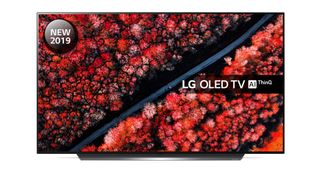
In total there are four HDMI inputs: three at the side and one facing the rear. There are also three USB ports, with one at the side and two facing rearwards, along with a terrestrial and satellite tuner, a LAN port, a CI slot, an optical digital output, and a line out that doubles as a headphone jack. On the wireless side of things, there’s built-in WiFi (802.11ac), Bluetooth (5.0) and AirPlay 2.
Like the rest of LG's OLED and Nano Cell line up, the C9 includes the latest version of the Magic Remote, which retains its fantastic ergonomic design. The controller is comfortable to hold and highly intuitive to use, thanks to a precise onscreen pointer. Five minutes with this zapper and all others are stone age by comparison.
The remote looks identical to last year, but LG has replaced any lettering with icons – presumably to make it applicable to all international markets. There’s still a built-in microphone that has multiple functions this year, along with direct access keys for Netflix, Amazon, and Rakuten.
Design TL;DR: The sleek and minimalist design remains as eye-catching as ever, while the use of HDMI 2.1 ensures the C9 will stay future-proof for years to come.
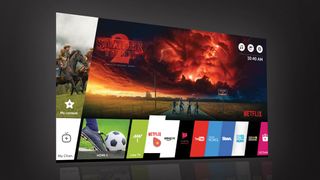
Smart TV (webOS with ThinQ AI)
The LG C9 boasts the latest iteration of webOS and while this game changing platform remains largely the same, there have been a few tweaks.
For a start there’s now a second tier on the launcher bar that’s very reminiscent of the one found on Samsung’s Tizen system. It’s rather ironic that LG should take inspiration from Samsung, especially when you consider that Tizen copied webOS in the first place, however the second tier is a useful feature, making it quicker to access content and adding an AI Preview that makes recommendations based on your viewing habits. There’s also a new Intelligent Edit feature that lists your apps based on how often you use them.
That’s very handy because the C9 has a lot of apps; not to mention a comprehensive selection of streaming services that includes Netflix, Amazon, YouTube, Now TV, Rakuten, and all the UK TV catch-up services.
The AI-enhanced recommendation feature monitors and analyses your viewing habits based not only on content but also the time of day. It will then make recommendations according its analysis, although there’s the option to turn this feature off if it gets annoying.
There’s a new Home Dashboard that collates all connected mobile, input and home IoT devices into a single hub. You can monitor and control just about any connected device in your smart home, and LG will be adding support for Homekit later this year.
LG’s ThinQ open AI platform already includes Google Assistant, and the company plans to add Amazon Alexa via a future firmware update. You can access Google by pressing the mic button on the remote, and then voice control your C9 or simply use it as a smart assistant.
Other new features include the ability to setup your C9 using an LG smartphone, and the ability to auto-detect connected HDMI devices. There’s also a mini-browser, a new TV channel banner, and an expanded Gallery mode with world famous travel attractions seasonally curated by TripAdvisor.
Smart TV TL;DR: webOS remains the most comprehensive and intuitive platform available, but the inclusion of AI-enhancements and voice assistants also make it the smartest.
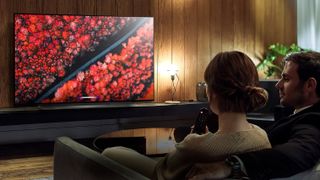
HD/SDR Performance
The LG C9 delivers all the picture benefits you would expect from an OLED TV: incredibly inky blacks and superior contrast ratios. It’s also extremely accurate, producing colours that are both natural and perfectly saturated.
The default Standard picture mode is sure to please many, with its bright punchy images and colours that pop. However those looking for pictures that adhere to the industry standards, will be delighted by the accuracy on offer in the ISF modes. None of this should come as a surprise, the C8 was just as impressive in terms of black levels and image fidelity.
However the 2nd-gen Alpha9 processor brings deep learning AI algorithms to bear that have a significant impact on the image. This processing accesses a database composed of millions of content examples, and uses this to analyse the picture and then optimise it depending on the type and quality of content.
This processing really works, with precise upscaling of lower resolution images and exceptional noise reduction and image enhancement. The results are often breathtaking, and when watching Gravity the detailed star fields looked better than they have on any other display.
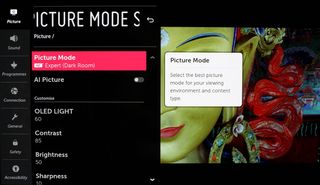
The de-contouring feature first introduce last year now has a separate control in the menu, and it’s highly effective at reducing banding in compressed content. There’s also AI Brightness, a new feature that uses a sensor to detect ambient light and then optimises the brightness based on the viewing environment, thus improving visibility in dark areas of the picture.
The result of all this processing is an SDR picture that is often staggering in its detail, precision, and accuracy. The images are clean, and free of noise and banding, while the upscaling makes full use of all the pixels in the 4K panel. We were also pleased to see that the picture didn’t suffer from the blocking and flashing artefacts that have affected previous LG OLEDs.
The Motion Pro black frame insertion (BFI) feature is better than last year, improving motion handling while appearing less susceptible to flicker. However in general, motion handling is probably the one area where LG is at a disadvantage to the competition as it's still a bit...aggressive.
The gaming performance is excellent, and the input lag is an imperceptible 12.7ms. That’s incredibly low, and when combined with VRR and ALLM it makes the C9 an obvious choice for gamers. Those concerned about image retention (commonly referred to as burn-in) shouldn’t lose sleep as LG employs a number of features built-in to mitigate the issue.
HD/SDR Performance TL;DR: The inherent benefits of OLED combined with the 2nd generation Alpha9 processor results in some of the best SDR images we’ve ever seen.
4K/HDR Performance
The LG C9 delivered an equally impressive HDR performance, despite only hitting a peak brightness of 780 nits. (OLED panels will never reach the levels of brightness seen on LCD-based technologies like Samsung’s QLED, but they have other advantages as you'll see shortly.)
For a start there are those amazing blacks, and these are important because dynamic range goes from absolute black to peak white. LG has also improved the performance just above black, thus revealing more shadow detail. In the past OLEDs often struggled to retain details as images came out of black, but that wasn’t an issue with the C9.
Since an OLED is self-emissive that means each pixel is individually controlled, essentially creating over 8 million dimming zones. This means an OLED can deliver an unprecedented level of detail in the specular highlights used to give HDR its impact. The C9 also tone mapped the content accurately, ensuring that these highlights didn’t lose detail or clip.
All these factors were evident when watching the scene in First Man where the Apollo 11 space craft first goes in to orbit around the moon. The screen is completely black and then the lunar surface appears through the command module window. It’s a scene that only an OLED can really do justice to, and the C9 delivered it perfectly.
The colours are equally as impressive, covering 100% of the DCI-P3 colour space used for HDR. This was easy to see when watching Guardians of the Galaxy Vol.2, which has an incredibly saturated image that the C9 rendered in all its glory.
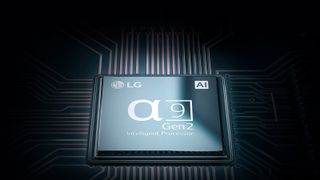
LG introduced a feature called Dynamic Tone Mapping two years ago, and this works particularly well when it comes to addressing the inherent brightness limitations of OLED. It analyses each scene on a frame-by-frame basis and adjusts the tone mapping accordingly, thus improving the HDR experience. This feature has been enhanced and improved on the C9, and the results were genuinely impressive.
The LG not only supports HDR10 and broadcast HLG, but also Dolby Vision. This uses dynamic metadata (not to be confused with dynamic tone mapping), and is available on a wide range of content including streaming and 4K Blu-ray. However there is another format that also uses dynamic metadata called HDR10+ and while the content catalogue is currently small, it’s growing.
At present LG doesn’t support HDR10+; in fact it’s the only version of HDR not included on its TVs. This is unfortunate because both Philips and Panasonic offer OLED TVs that support Dolby Vision and HDR10+, a fact that will undoubtedly prove popular with those keen to have both formats on their TV.
4K/HDR Performance TL;DR: It might not be as bright as QLED, but this is still a superb HDR performance. Only the lack of HDR10+ support disappoints.
Sound
The LG C9 sounds remarkably good, especially when you consider it measures mere millimetres at the top and only reaches 46.9mm at the bottom. That doesn’t leave a lot of room for speakers, but LG has applied some clever AI processing to provide acoustical assistance.
To start with, you can actually optimise your new C9 for the specific room you’re using it in. There’s a new One Touch Sound Tuning feature that uses the mic in the remote to analyse the room from your main listening position and set-up the TV accordingly.
Once the AI acoustic tuning has finished, you can compare before after prior to saving the settings. This feature really works, and the sound retains excellent detail and crisp clarity. There are three modes as well, with the Standard option providing the most balanced results. However, if you feel like boosting the treble or bass you can, and the results are impressive.
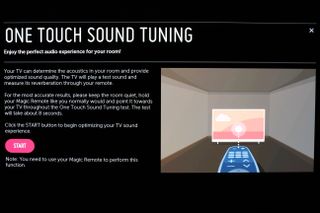
There’s also an AI Sound mode that up-mixes 2.1-channel audio to virtual 5.1 surround sound. Thanks to the clever application of psychoacoustic trickery the sound benefits from staging that seems bigger and more open. The dialogue remains clear but music and effects are more enveloping, while the bass is surprisingly deep.
As with previous years, the C9 supports Dolby Atmos. You can't apply AI processing in this mode, but then why would you? Dolby Atmos is natively encoded with discrete surround channels, and although the TV is creating its sound field with only a pair of speakers, the results are often highly immersive. The audio capability of these modern TVs is nothing short of amazing.
Sound TL;DR: The sound quality is remarkable considering how ultra-slim this TV is. The AI-enhanced processing really works, as does the acoustic tuning.
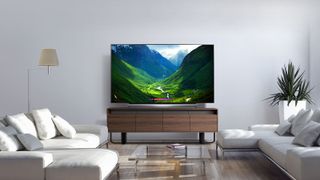
The LG C8 OLED is the predecessor to the C9 and still one of the best OLED TVs around.
Other panels to ponder...
It’s still early in the 2019 TV release schedule, but that does mean if you’re on a tight budget last year's LG C8 OLED is being heavily discounted. While the C9 is an improvement over last year’s model, the C8 remains a superb 4K OLED. There’s also the option of the cheaper LG B9 OLED coming later this year that doesn’t use the Alpha9 processor but retains most of the other new features.
If you’re thinking of alternative manufacturers, Sony has already released its new AF9 Master Series OLED TV. This excellent 4K model delivers impressive image accuracy and includes Dolby Vision, along with Sony’s clever Acoustic Surface. However the panel is quite dim, and there’s no support for HDR10+.
Probably of greater interest are the Panasonic GZ1000 and Philips 804 OLED 4K TVs. While neither of these models is quite as feature-packed or smart as the C9, they do support both Dolby Vision and HDR10+, thus pleasing anyone wishing to cover their high dynamic range bases.
Finally if you prefer an LCD panel, then check out the excellent Samsung Q90uses direct QLED backlighting to deliver near-OLED blacks, improved viewing angles and a high peak brightness. It also has a very low input lag and won’t suffer from image retention or screen burn, making it a great choice for both HDR and gaming.
Final verdict
The LG C9 is a truly exceptional 4K OLED TV that takes what was so impressive about last year’s C8 and builds on it. The major difference is the inclusion of the 2nd generation Alpha9 processor, which uses AI enhancements to deliver stellar SDR and HDR images, and helps make the upscaling and processing second-to-none with incredible levels of detail and image fidelity.
As is the case with all OLEDs the panel brightness pales when compared to an LCD TV, but brightness isn’t everything. The absolute blacks and pixel level of precision afforded by the self-emissive technology ensures that HDR looks stunning. There’s support for Dolby Vision as well, and only the absence of HDR10+ disappoints.
Finally, the TV’s smart platform remains state-of-the-art, and now boasts the inclusion of both Google Assistant and Amazon Alexa. webOS has been tweaked but still includes a comprehensive selection of streaming services, while AI powers the recommendation features. Meanwhile, the new Home Dashboard turns your TV into a hub for your smart home.
Overall, the LG C9 represents a clear evolution in the development of OLED, and it not only delivers amazing pictures and sound, but is also the smartest 4K TV on the market.

Comments
Post a Comment